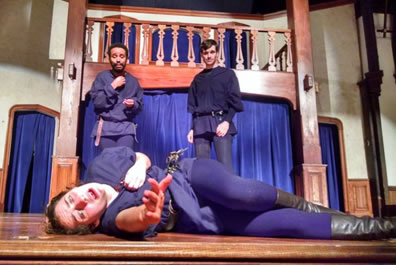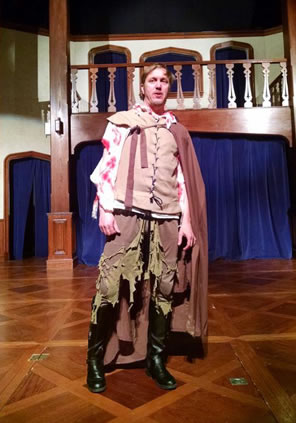The Complete Deaths of William Shakespeare
The Dead and Dying Make for Live! Theater
Written by William Shakespeare and Alice Stanley
Baltimore Shakespeare Factory and Cohesion Theatre Company, St. Mary's Community Center, Baltimore, Maryland
Saturday, January 16, 2016, third pew of old church
Directed by Alice Stanley and Tom Delise

Melanie Glickman plays one of many characters to meet their demise in a William Shakespeare play as Dominic Gladden (left) and Chris Cotterman look on in The Complete Deaths of William Shakespeare. Photos courtesy of Cohesion Theatre Company.
In this the 400th anniversary year of William Shakespeare's death, the Baltimore Shakespeare Factory in a co-production with Cohesion Theatre Company marked the occasion with a presentation of the deaths of William Shakespeare. That's plural deaths—74 in all, including a couple of staged deaths.
About 155 of Shakespeare's characters die in his 38-play canon. Less than half of those suffer their demise onstage, and it is those characters plus one fly featured in The Complete Deaths of William Shakespeare. That, as the program notes point out, is more than the number of characters Game of Thrones has killed off in five seasons. This show also fudges on a few offstage deaths to get them into the play, too. Macbeth, for instance: his fatal fight with Macduff moves offstage before Macduff comes running back with Macbeth's head (and in this production we can hear the brawl though we can't see it). Nevertheless, you gotta have Macbeth v Macduff because this show is more than a kick-off to a year of myriad anniversary commemorations, events, and projects across the Shakespearean theater landscape: this 90-minutes production is really a celebration of stage combat.
As Fight Captain Tegan Williams pointed out in an after-show talkback, the cast of eight "combatants" couldn't do a pre-curtain fight call because "we can't do the whole show, so we just do what we messed up last night." Unfortunately, there were only two "last nights," as this production was limited to a three-show run. That's a shame. Because of its subject matter, its form of presentation, and the fact that audiences of some 200 at each show shed a lot of love on the dying and the dead, The Complete Deaths of William Shakespeare should be packaged as a road show and tour the festival circuit this year. A forecast of what you're in for comes during the preshow music played by Alice Stanley and Nick Delaney, which includes Blue Oyster Cult's "The Reaper," so there's nothing to fear here.
The show's genesis was Tom Delise, Baltimore Shakespeare Factory (BSF) founder and artistic director, making a list of Shakespeare deaths. This tally makes you realize how much the "bloody" Shakespeare tends to kill more people out of public view than onstage. Do your own list of ten famous deaths in Shakespeare, and I bet more than half are offstage: Ophelia, for example, Mercutio, and Antigonus pursued by a bear (nevertheless, Mercutio and Antigonus are included in this production, but the latter at least has parts of his body returning to the stage). I've written on this site about the playwright's obviously intentional device of having every character in Richard III die offstage except the title character (Clarence is stabbed onstage and drowned in a butt of malmsey offstage, but his stabbing is included in Deaths). Looking at Delise's chart, I realize that Shakespeare's "intent" wasn't singular to Richard III, and it therefore may have been as much for practical purposes as poetic. Henry V, for example, has 11 deaths, the same number as Richard III, but all occur offstage, including Bardolph's, which many directors like to show us.
Bloodiest play? Titus Andronicus earns that tag thanks to the number of body appendages whacked off along with its 15 fatalities (all but five onstage, including the fly). However, the Shakespeare play featuring the highest death toll is Henry VI, Part Two, with 18, ten of those onstage.
Delise turned his list over to Stanley, Cohesion Theatre's founding artistic producer, who organized it into a script. She took two particularly smart steps. One was to come up with a narrator, and who better to take us through his deaths—starting with his own—than William Shakespeare himself, played by Jonas David Grey as an irreverently witty zombie very much aware of his 400-year place in literary and theatrical history. Stanley also decided not to present the deaths in chronological order but organize them thematically: by manner of death and circumstances. This spreads out some of the more iconic fatalities across the proceedings.
She starts with Caesar's assassination, for example, and then moves into death by assisted suicide, which, as Zombie Shakespeare tells us, "was not such a big issue in my day." This, naturally, moves into death by broken heart and into Antony and Cleopatra (a play with two fatal broken hearts, neither of whom are the title characters'). All the histories are lumped together and become something of an exercise in "one-up-this" as barely known character after character demise with panache and passion. Other plays get extended and serious treatment—including Titus Andronicus. Brad Norris plays Titus true to the text, without any hint of satirical intent or irony in his expression, even on the matter of murdering a fly. This, it turns out, makes those passages even funnier in the wink-eyed context of this show.
At one point, Zombie Shakespeare sidetracks into "meaningless deaths." He includes Iago ("the worst best friend ever," Shakespeare says) stabbing Roderigo ("That's just mean"); Banquo's murder in Macbeth followed by Lady Macduff and her son being offed; the First Servant in King Lear, the one who tries to intervene in Cornwall gouging out Gloucester's eyes; Oswald, another servant in Lear; Polonius in Hamlet; and, back to Macbeth, Young Siward killed in the battle of Dunsinane. Dispensing with Roderigo, Polonius, and the servants allows for a more serious exploration of the more important trio of deaths at the climax of Othello, a really bizarre presentation of the quartet of deaths at the climax of Hamlet, and a ridiculously flippant rendering of the quintet of deaths at the climax of King Lear.
Though Delise and Stanley co-directed Deaths, they gave their companies' fight choreographers, Norris for Cohesion and Williams for BSF, carte blanche on how to present each death, which is akin to turning the asylum over to the inmates. They set the production's overall tone in the first scene with the mob assassination of Caesar: one conspirator after another use knives to stab the dictator before Chris Cotterman as a grinning Brutus wields a battle axe while standing astride the prone Caesar. "Et tu, Brute?" is something of an understatement before Cotterman's Brutus gives Caesar a mighty chop.

Zombie Shakespeare (Jonas David Grey) leads the audience through the Baltimore Shakespeare Factory's and Cohesion Theatre Company's production of The Complete Deaths of William Shakespeare at St. Mary's Community Center. Photo courtesy of Cohesion Theatre Company.
The combatants, dressed in blue tunics, tights, and a few visible kneepads (costume designs by April Forrer) present some of the deaths with clever inside-theater humor. Hotspur (Zach Bopst) dies in midsentence, prompting Hal (Jessica Byars) to prompt Zombie Shakespeare with "line?" Other deaths play up the humor in Shakespeare's lines, such as in Titus Andronicus. The murder of Clarence in Richard III also proves to be a genuinely comical sequence, particularly in the part of First Murderer, brilliantly played by Dominic Gladden as he whets and carefully inspects his knives while casually casting off one-liners and cynical expressions (Gladden also turns in a sympathetically poignant Othello later in the show).
And some of the deaths are depicted with an irreverence that seems to be genetic in fight choreographers. Hal and Hotspur duel with pencils, Macbeth (Cotterman) and Young Siward (Katherine Vary) use light sabers (two actors vocalize the sound effects in the background), and Norris and Williams dance a tango to the death as Edgar and Edmund in King Lear. Instead of rapier and dagger, Hamlet and Laertes engage in a game of Battleship for their climactic showdown. "F-6," Hamlet calls out, and though Laertes is loathe to admit it, Osric announces "A hit!" So disarming is this device that you don't see the real joke coming. "2-B?" Hamlet ponders as he looks at his board: "Or not 2-B?" That's no more ridiculous than the ensuing fight with the Battleship game pieces, Hamlet and Laertes stabbing each other with a poison-tipped peg. (In the after-show talkback, Norris said of this staging, "We wanted to rip the rug out from under the reverence the play deserves.")
However, other deaths are treated with utmost respect: Othello, Richard II, even Titus, and the most famous of Shakespeare's deaths, Romeo and Juliet. After a particularly skillful swordfight between Tybalt (Melanie Glickman) and Mercutio (Cotterman), and then Tybalt and Romeo (Bopst), we skip ahead to the monument scene and Romeo's killing of Paris (Williams). Romeo is about to enter the monument, when he is waylaid by Norris who tells Romeo to sit down and watch how this scene needs to be done. Zombie Shakespeare is about to protest until he realizes who Norris is portraying: Bottom, who then plays Pyramus's death scene (followed by Flute as Thisbe) in A Midsummer Night's Dream's theatrical send-up of "Pyramus and Thisbe." Hey, they are both onstage deaths in a Shakespeare play, so they count. And Zombie Shakespeare has to admit that he sometimes did repeat himself (the plays were written about the same time, and Dream could well have been a parody of the popular Romeo and Juliet; though the notion that the comical rendering of Pyramus and Thisbe in Dream inspired Romeo and Juliet is an intriguing theory, too). This interlude done, Bopst's Romeo gets back to his own, truly heartrending death, and Juliet (Vary) follows with her suicide, played out seriously and touchingly.
These may be the most climactic of Shakespeare's deaths, but the denouement in this production brings more carnage as the eight combatants engage in a multiweapon battle royal on the main stage and in the balcony above. Clangs, screams, thuds, yells, whooshes, and squeals fill the air until the last two standing (actually, kneeling in exhaustion) combatants kill each other simultaneously. Zombie Shakespeare walks among the bodies and then raises the eight actors back to zombie life.
His knowing smile is the key to this final moment of The Complete Deaths of William Shakespeare because both playwright and his characters never really die—they are still living 400 years on.
Eric Minton
January 22, 2016
Comment: e-mail [email protected]
Start a discussion in the Bardroom



 Find additional Shakespeareances
Find additional Shakespeareances